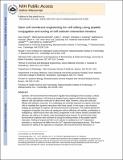Stem cell membrane engineering for cell rolling using peptide conjugation and tuning of cell–selectin interaction kinetics
Author(s)
Cheng, Hao; Byrska-Bishop, Marta; Zhang, Cathy T.; Kastrup, Christian; Hwang, Nathaniel S.; Tai, Albert K.; Lee, Won Woo; Xu, Xiaoyang; Nahrendorf, Matthias; Anderson, Daniel Griffith; Langer, Robert S; ... Show more Show less
DownloadAnderson_Stem cell membrane engineering.pdf (3.209Mb)
PUBLISHER_CC
Publisher with Creative Commons License
Creative Commons Attribution
Terms of use
Metadata
Show full item recordAbstract
Dynamic cell–microenvironment interactions regulate many biological events and play a critical role in tissue regeneration. Cell homing to targeted tissues requires well balanced interactions between cells and adhesion molecules on blood vessel walls. However, many stem cells lack affinity with adhesion molecules. It is challenging and clinically important to engineer these stem cells to modulate their dynamic interactions with blood vessels. In this study, a new chemical strategy was developed to engineer cell–microenvironment interactions. This method allowed the conjugation of peptides onto stem cell membranes without affecting cell viability, proliferation or multipotency. Mesenchymal stem cells (MSCs) engineered in this manner showed controlled firm adhesion and rolling on E-selectin under physiological shear stresses. For the first time, these biomechanical responses were achieved by tuning the binding kinetics of the peptide-selectin interaction. Rolling of engineered MSCs on E-selectin is mediated by a Ca[superscript 2+] independent interaction, a mechanism that differs from the Ca[superscript 2+] dependent physiological process. This further illustrates the ability of this approach to manipulate cell–microenvironment interactions, in particular for the application of delivering cells to targeted tissues. It also provides a new platform to engineer cells with multiple functionalities.
Date issued
2012-04Department
Harvard University--MIT Division of Health Sciences and Technology; Massachusetts Institute of Technology. Department of Chemical Engineering; Koch Institute for Integrative Cancer Research at MITJournal
Biomaterials
Publisher
Elsevier
Citation
Cheng, Hao, Marta Byrska-Bishop, Cathy T. Zhang, Christian J. Kastrup, Nathaniel S. Hwang, Albert K. Tai, Won Woo Lee, et al. “Stem Cell Membrane Engineering for Cell Rolling Using Peptide Conjugation and Tuning of Cell–selectin Interaction Kinetics.” Biomaterials 33, no. 20 (July 2012): 5004–5012.
Version: Author's final manuscript
ISSN
01429612
1878-5905